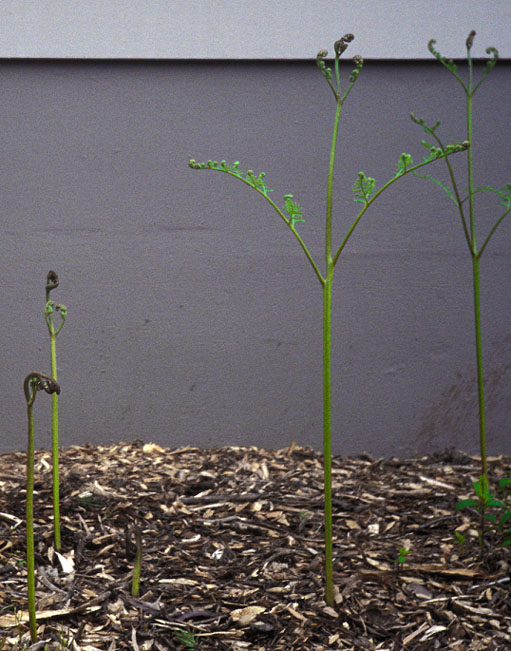
|
| Bracken; Pteridium aquilinum (L.) Kuhn |
Bracken Family; DENNSTÆDTIACEÆ
|
| Bracken is earth's most common fern. Of Seattle's eight native fern species only Bracken
must appear in a weed book. It is one of those plants everyone at all familiar with the plant kingdom should know. |
| Other names for this cosmopolitan celebrity are Brake, Adder Spit, and Eagle Fern. The latter name is simply an adaptation of
the specific Latin name, which was given for reasons now unknown: at least three theories have been advanced to explain why this fern
has anything do to with the King of Birds. In Japan the plant is called Warubi. |
| Most ferns grow in compact clumps, radiating a whorl of fronds from a common center. Bracken runs around wildly by means of
an extensive underground rootstock, periodically shooting above earth a frond. Our illustration shows the beginning of such a frond, in
the tender young stage when it is called a fiddlehead or crosier. Fern fiddleheads generally unwind in spring. With Bracken in
Seattle, fiddleheads can be found eight months out of the year! From the last week of February into September. But late March through May is
the prime time. |
| The fiddleheads are pliable, almost rubbery-feeling, especially after a scruffy reddish fuzz is rubbed off. If you squish or nibble
them, a slimy juice of pronounced flavor is experienced. Disliking the flavor, I do not eat them. But countless people have eaten and greatly
enjoyed these fiddleheads cooked as an asparagus substitute. In fact the Bracken appears in nearly all wild edible food guides. For all that,
beware! Raw Bracken contains an enzyme that can hurt the body's vitamin B1 reserves. Even cooked, a carcinogenic property is present.
Though the plant is common, well known and widely eaten, the result of excessive consumption may be cancer. Alas, arguments rage over
what constitutes "excessive" consumption. Some would say eat none; others claim the good outweighs the bad. |
| The fiddleheads grow up and unwind. Locally they can be found over nine feet in height, but in the Andes can reach 14 feet. In
starved, poor places, only three feet or less may be achieved. By late summer the frond has become firm, even crinkly, and has released dusty
spores. Ferns make spores, flowering plants produce seeds. I have found weedy seedlings of Lady Fern and Sword Fern in gardens, but none
of Bracken. It seems to rely largely on its rampant roots to propagate itself. There is an Old World tradition that if a person captures the
spores of Bracken ("fern seed" so called) on a white napkin, at midnight, on Saint John's Eve, then invisibility results. If this is true it would
be very useful sometimes. But who has tested the tradition? |
| In winter Bracken turns to the dismal color of cardboard and begins its gradual decomposition. The black, creeping rootstock is
now the subject of attention. Many Indians harvested the roots as a foodsource. I tried the recipe in January, 1980, and was not impressed,
so have not done so since then. After boiling the roots for about an hour, and inhaling a delicious aroma like that of potatoes cooking, the
time for tasting was at hand. First peeling was done. This left a thin core of fiber and flavor. So then the
peelings were eaten, proving chewy and starchy. A judgment of "survival food only" was the inevitable conclusion after such prolonged pains yielded so little pleasure. |
| There is a dearth of information on the Bracken's medicinal value. In very few herbal books is it treated; the consensus is that is has
little use. |
| As an ornamental it is impossible, because however pretty we may deem it, there is no way to control it, and humans generally
are keenly possessed by the urge to control. Bracken disdains being "nice and neat" and invasively outruns any bounds we set. With such
vigor, it makes clear-cuts green, and pioneers in any sunny sites it can. Shade it dislikes but tolerates to a degree. |
If you have an infestation in your yard and care to get rid of it, three years of pulling
every frond that appears should do the job. Do not merely cut or snap the fiddleheads or fronds. Pretend each stem is a carrot, and firmly tug it out of the earth. You can compost the
green portions safely, but the black underground parts should be thoroughly dried first. With persistence, you can banish this coarse pest, or
at least keep it at bay (i.e. in your neighbor's yard). Pulling out Bracken stems is a weeding task more substantial than forking up
dandelions or hoeing down seedlings. In late summer and fall especially, the stems are stout, the fronds large, and a very large pile can soon
accumulate. When you are done, a big difference in the landscape will be apparent, but you know you will need to return next spring, and the
spring thereafter, to attack the fiddleheads.
|
Originally published as the Seattle Tilth newsletter Weed of the Month in April 1991, along with an illustration drawn by Annie Figliola.
Back |
|
|

